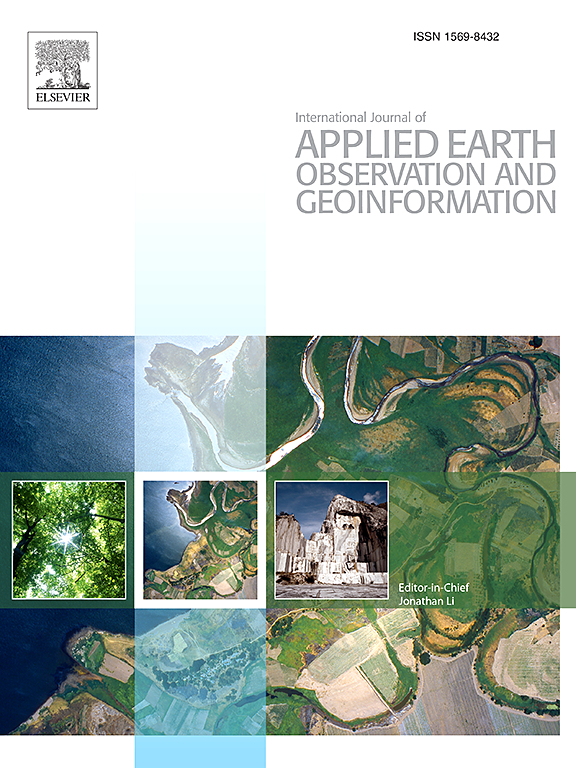Decoding spatial consistency of multi-Source land cover products in China: Insights from heterogeneous landscapes
IF 7.6
Q1 REMOTE SENSING
International journal of applied earth observation and geoinformation : ITC journal
Pub Date : 2025-04-11
DOI:10.1016/j.jag.2025.104529
引用次数: 0
Abstract
High-resolution land cover (LC) data are essential for ecological monitoring and resource management, especially in heterogeneous landscapes containing diverse LC types. With the growing of available LC products, a comprehensive evaluation of their classification accuracy and spatial consistency is important for users’ selection and application. In this study, we compared eight widely used LC products in China, including ESA World Cover (ESA20), ESRI GLC10 (ESRI17, ESRI20), FROM-GLC10 (FROM-GLC17), CLCD (CLCD20), GlobeLand30 (GLB20), GLC_FCS30 (GLC_FCS20), and GLC_FCSD30 (GLC_FCSD20), to examine their performances at both national and regional scales. We employed pixel-wise overlay analysis, visually interpreted validation samples, and classical landscape metrics to assess overall consistency and classification accuracy. The results show that the 30m_combination (CLCD20, GLB20, GLC_FCS20, and GLC_FCSD20) exhibits higher overall consistency at the national scale, with perfect consistency exceeding 60 %. In contrast, the 10m_combination (ESA20, ESRI17, ESRI20, and FROM_GLC17) captures finer regional details but displays greater inconsistencies in central and western regions. ESA20 achieves the highest overall accuracy (OA) at 88.5 % (CI: 88.44 %–88.56 %), while FROM_GLC17 records the lowest at 82.79 % (CI: 82.73 %–82.85 %). Cropland, forest, water, and snow/ice demonstrate higher consistency and classification accuracy (F1-scores > 80 %), whereas wetland, grassland, impervious surfaces, and bare land underperform in fragmented regions. Furthermore, spatial consistency is strongly associated with landscape metrics such as the aggregation index (AI) and contagion (CONTAG), which enhance consistency in large, contiguous patches (e.g., Northeast China Plain). Conversely, edge density (ED) and patch density (PD) show negative associations with consistency, highlighting persistent mapping challenges in fragmented regions (e.g., Yunnan-Guizhou Plateau and Qinghai-Tibet Plateau). These findings offer actionable insights for improving LC mapping in complex terrains and underscore the critical role of landscape metrics in advancing ecological monitoring and resource management.
解读中国多源土地覆盖产品的空间一致性:来自异质景观的启示
高分辨率土地覆盖数据对生态监测和资源管理至关重要,特别是在包含多种土地覆盖类型的异质景观中。随着可用LC产品的不断增加,对其分类精度和空间一致性的综合评价对用户的选择和应用具有重要意义。本研究以ESA World Cover (ESA20)、ESRI GLC10 (ESRI17、ESRI20)、FROM-GLC10 (FROM-GLC17)、CLCD (CLCD20)、GlobeLand30 (GLB20)、GLC_FCS30 (GLC_FCS20)、GLC_FCSD30 (GLC_FCSD20)等8种国内广泛使用的LC产品为研究对象,比较了它们在国家和区域尺度上的性能。我们采用逐像素叠加分析、视觉解释验证样本和经典景观指标来评估总体一致性和分类准确性。结果表明,CLCD20、GLB20、GLC_FCS20和GLC_FCSD20的30m_组合在全国范围内具有较高的整体一致性,完全一致性超过60%。相比之下,10m_组合(ESA20、ESRI17、ESRI20和FROM_GLC17)捕获了更精细的区域细节,但在中西部地区表现出更大的不一致性。ESA20的总体准确率最高,为88.5% (CI: 88.44% - 88.56%),而FROM_GLC17的总体准确率最低,为82.79% (CI: 82.73% - 82.85%)。农田、森林、水和冰雪表现出更高的一致性和分类精度(F1-scores >;80%),而湿地、草地、不透水地表和裸地在破碎化地区表现不佳。此外,空间一致性与聚集指数(AI)和传染(CONTAG)等景观指标密切相关,它们增强了大型连续斑块(如东北平原)的一致性。相反,边缘密度(ED)和斑块密度(PD)与一致性呈负相关,突出了碎片化地区(如云黔高原和青藏高原)持续的制图挑战。这些发现为改善复杂地形的LC制图提供了可行的见解,并强调了景观指标在推进生态监测和资源管理中的关键作用。
本文章由计算机程序翻译,如有差异,请以英文原文为准。
求助全文
约1分钟内获得全文
求助全文
来源期刊

International journal of applied earth observation and geoinformation : ITC journal
Global and Planetary Change, Management, Monitoring, Policy and Law, Earth-Surface Processes, Computers in Earth Sciences
CiteScore
12.00
自引率
0.00%
发文量
0
审稿时长
77 days
期刊介绍:
The International Journal of Applied Earth Observation and Geoinformation publishes original papers that utilize earth observation data for natural resource and environmental inventory and management. These data primarily originate from remote sensing platforms, including satellites and aircraft, supplemented by surface and subsurface measurements. Addressing natural resources such as forests, agricultural land, soils, and water, as well as environmental concerns like biodiversity, land degradation, and hazards, the journal explores conceptual and data-driven approaches. It covers geoinformation themes like capturing, databasing, visualization, interpretation, data quality, and spatial uncertainty.
 求助内容:
求助内容: 应助结果提醒方式:
应助结果提醒方式:


